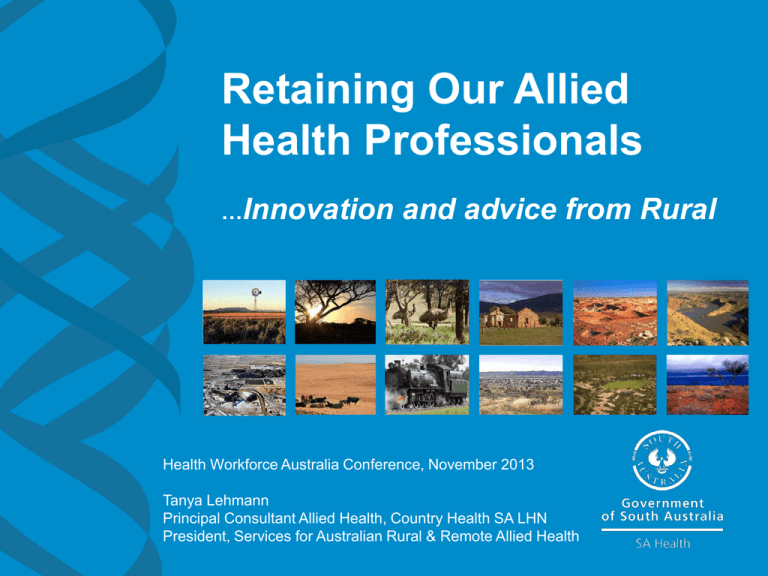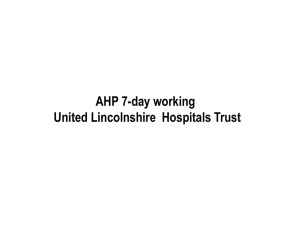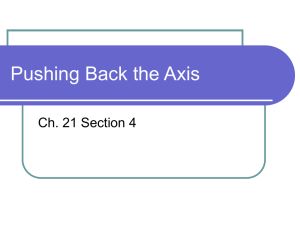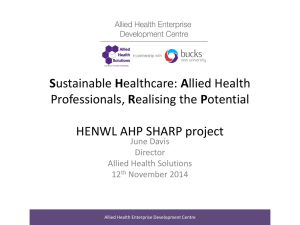Retaining Our Allied Health Professionals
advertisement

Retaining Our Allied Health Professionals …Innovation and advice from Rural Health Workforce Australia Conference, November 2013 Tanya Lehmann Principal Consultant Allied Health, Country Health SA LHN President, Services for Australian Rural & Remote Allied Health Acknowledgement SA Health Overview of Presentation > Why do we need more Health Professionals in rural & remote Australia? > What does the evidence say about retention of AHPs? > The CHSALHN Allied Health journey > How do we get and retain more AHPs in rural and remote Australia? SA Health Rural and Remote Australia > Home to 1/3 of Australians • Higher proportion >65, lower proportion <25 yrs > More likely to be obese, smoke, drink alcohol to excessive levels, be less physically active; have a disability; die from cancer, heart disease, suicide > More likely to have lower income, education, employment > More likely to work in high risk job > More likely to be Aboriginal (70%) > Health status declines with increasing remoteness Remoteness Areas in Australia Source: ABS (2008) Australian Social Trends. SA Health Access to Health Services > Decreases with increasing remoteness > 2006-7 Annual shortfall of primary health care expenditure of $2.1 billion • • • MBS/PBS - access to doctors, dentists, pharmacies 25 million services (2006-7) Contributed to need for an extra $830 million to be spent on acute (hospital) care, or 600,000 extra acute episodes > Plus ‘other PHC’ deficit of at least $800 million • allied health professionals, oral health care, equipment > Plus ‘aged care’ deficit of $500 million • Lower access and longer waits for residential aged care > Total $3 billion PHC and Aged Care deficit > $829 million overspend on hospital care • Rural & remote people twice as likely to be admitted to hospital for potentially preventable admission > largely attributable to health workforce gaps 1. The National Rural Health Alliance, Fact Sheet 27 SA Health Maldistributed Health Workforce > 23% Australia’s Doctors, 25% Physiotherapists > Relative number of health professionals decreases with increasing remoteness (except nursing) > Impact of: • • • Funding/employment models (market failure) Population (demographic profile, critical mass for specialty) Context (professional isolation, community infrastructure) Sources: AIHW nursing and midwifery labour force survey 2009, AIHW Medical labour force 2009, and AIHW Health and community services labour force SA 2006 Health Evidence: Retention of AHPs > Australian research focus on Doctors • attract higher incomes, government-funded incentive schemes (training, relocation, retention) • practice under a small business model of patient care > Profile of AHPs is different • Younger (mean 36), female (>80%) • Public / private sector employment > Can’t assume the same factors attract and retain AHPs as work for Doctors > Factors that attract AHPs to commence rural practice differ from those that influence them to remain.1 > Factors differ by remoteness of the position 1. Schoo, A. M., Stagnitti, K. E., Mercer, C., & Dunbar, J. (2005). A conceptual model for recruitment and retention: Allied health workforce enhancement in Western Victoria, Australia. Rural and Remote Health, 5: 477. SA Health Professional Factors - Work is challenging, has impact - Access to support, CPD - Infrastructure & equipment - Career pathway, remuneration Social Factors - Personality (adventure seeking, risk taking) - Personal aspirations (altruistic) - Affordable housing, community amenities & infrastructure - Spouse employment External Factors - Geographic location – lifestyle, friendly community Adapted from: Humphreys, J. S., Wakerman, J., Wells, R., Kuipers, P., Jones, J., Entwistle, P. & Harvey, P. (2007). Improving primary health care workforce retention in small rural and remote communities – How important is ongoing education and training? Australian Primary Health Care Research Institute, Canberra, ACT. Personal and Professional Satisfaction LOW Modifiabilty HIGH Retention of AHPs Workforce Retention SA Health CHSALHN Allied Health 2006 > Approximately 360 headcount • 13% of SA Health AHPs to service 33% SA population > 15% of AHPs in SA (all sectors) in country compared to 24% rural & remote nationally (2001 Census) > Very flat structure • • 90% AHPs ‘base grade’ Of 10% ‘senior’, 50% in non-clinical roles > Limited relationship with others of same profession > Little growth identified in most professions over previous 10 years > On average, 3.5 years younger than metro AHPs • In general, younger staff further in more remote locations > Few with tenure >4 years, most >2 years > Vacancy rates high • Ranging from 16% Dietetics, to 29% Physio, 53% Podiatry > Staff “invisible to” / not valued by metro colleagues SA Health Opportunities for Improvement “ Necessity is the Mother of invention, but Irritation is the Father “ > > > > > > > > > > Career structure / opportunities Access to professional development Access to professional supervision / support Use of allied health assistant / clinical support roles Professional networks Readiness for remote/rural practice Workforce tracking capacity Workload measurement and management Access to /effective use of IT Inequitable access to services SA Health The journey > 2008 Country Allied Health Advisory Group > 2008/2009 AHP Workforce Development Project • • • • • • County Allied Health Forum Workforce data, including SA AH Workforce Survey Simplified and standardised HR processes, job descriptions Designed AHP Career Structure Professional Networks Country Allied Health Collaborative > 2009 Country Allied Health Clinical Enhancement Program (CAHCEP) $75K > 2010 AHP Schedule in Enterprise Agreement • Addition of $250K CPD funding to CAHCEP > 2008/9 Supervision and Mentorship Project • • • • Clinical Support Policy, Framework 2010 Clinical Governance Structure - $800K investment by CHSALHN in Clinical Leads (x9), Clinical Seniors (53) 2011/12 Clinical Supervision training 2013 Clinical Supervision eModules, adoption State-wide > 2010, 2013 Recruitment campaigns > 2011/12 ASHP Leadership Group, AH Line Mgrs SA Health SA Health CHSALHN Allied Health Now > Approximately 500 headcount • 25% of SA Health AHPs to service 33% SA population > Clear career structure • • EA: clinical, management, education/research Clinical leadership roles in CHSALHN (location negotiable) > Strong professional networks across CHSALHN > FTE growth in all professions, moving towards more equitable distribution by population > Still younger than metro, but much better supported and retaining for longer • More with tenure >4 years > Vacancy rates lower for all professions > Other SA LHNs and jurisdictions are picking up and adopting our frameworks, training > More applications from metro clinicians for country senior jobs SA Health SA Health More AHPs in rural and remote > Supply, Attraction and Retention > Training & professional support • Education, training, recruitment, retention incentives • Rural pathways, Rural Generalism > Recruitment • Filling vacant positions, backfill leave • Increasing the number of ‘positions’ Viable private practice, joined up workforce Public / private work, flexible work arrangements > Retention • Meaningful work sustainable, effective service models - Assistants, telehealth, evaluation, research, publication Career pathways and flexibility • Good support: supervision, CPD, peer support • Focus on social & personal factors SA Health Tanya Lehmann Principal Consultant Allied Health Country Health SA Local Health Network tanya.lehmann@health.sa.gov.au 0437 293 627








